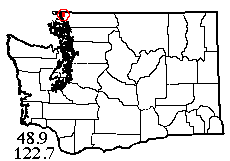
Spider Collector's Journal (2nd page: 1990) Copyright © 2005 by Rod Crawford
As explained on the first page, most of these notes of fun (and not so fun) trips to collect spiders for research at the Burke Museum appeared in Scarabogram, newsletter of "Scarabs: The Bug Society," in their original forms. References to the editor mean me; most other persons mentioned are Scarabs members. Dates of field trips head each paragraph. Maps showing the location of sites within Washington state follow the grid system outlined in the Washington Spider Checklist. RETURN TO INDEX
 |
25 III 1990: Yr editor's first collecting trip this spring was on March 25, when I and photographer friend Laszlo visited Birch Bay State Park (Whatcom County) and nearby Seimiahmoo Spit on the northernmost section of Washington coast. The state park yielded most of the early spring spiders; the most interesting specimens of the trip were the first Larinioides cornutus orbweaver from Puget Sound and the first "seaside earwig," Anisolabis maritima, I have collected, both from the beach meadow habitat at Semiahmoo Spit. This spit, across from Blaine, is mostly developed, but has a tiny swatch of "real habitat," itself rather altered, in a county park. At sunset I was visited by a friendly cat who, according to his ID tag, was Big Chief Semiahmoo.
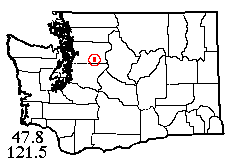 |
29 III 1990: On March 29, Bob and Lois Zahler took me up to their "little place" on the south fork of the Skykomish, just south of Index. They have (I think) 20 acres on the river, including a good variety of habitats: mixed forest, riparian cottonwood-alder-maple forest, clearing along the former railroad route, beaver marsh, riverine gravel bar, and a yard/garden inhabited by Lois's sister's many cats, with woody debris from a collapsed shed; not to mention the beehives. I came away with 29 spider species (in 5 hours), and can strongly recommend the site for a future Scarabs field trip. On the gravel bars, the large wolf spider Pardosa lowriei had obviously been active for some time already, since the population was mostly females.
 |
1 IV 1990: On April 1, I went on a mixed collecting and pleasure trip, with my friend Joyce and her dog Abra, to the south fork of the Stillaguamish River between Granite Falls and Verlot. For some reason, the season was retarded here by several weeks, and the highway was actually blocked by snow at Verlot! Nonetheless, some very interesting spiders were taken in and near the remains of a natural clearing which the timber (or shall we say "robber") baron owner has planted with trees! We also went about 1/3 of the way up the trail through Lake 22 Research Natural Area; the lowest part of the trail had snow, whereas the terrain up above the river valley was snow free! This is one of the nicest examples of old growth hemlock and cedar close to Seattle; I collected some bark for the Burke Museum's coming old growth exhibit.
 |
28-9 IV 1990: On April 28, some caver friends, on their way to get underground, dropped me at a site of ponds, gravelly clearings, and cottonwood forest on the flood plain of the Skagit River southwest of Newhalem (North Cascades Highway). Pickings here were rather slim, and it sprinkled off and on, but I did manage to get my quota of spider records. The next day was considerably better; it was the long-planned "official" Scarabs trip to the Ellensburg area. In the car, besides yr editor, were Scarabs Livingston, Wilson, Chandler, and Estelle's nephew Daniel (also a new Scarab). The presence of Estelle on a trip is alone sufficient guarantee that the trip will be fun! I had them drop me off at a site on Manastash Creek, near the joining of the north and south forks, that I had had my eye on since a brief visit ten or twelve years earlier. While I sloshed through the swampy woods to my riparian meadow, the others stayed near the road a while for what was to be their best collecting of the day. I have no complaints in the spider department: the day yielded circa 30 species, including the first Washington species of the "microspider" genus Diplocephalus.
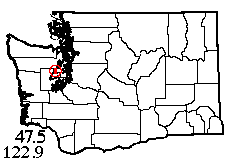 |
3 V 1990: The most productive spider trip yet this year was my May 3rd visit with Scarab Susan Anderson to Anderson Cove (no relation) on the Kitsap side of Hood Canal. This is in the last partially "wild" corner of Kitsap County, and contains several habitats well worth preserving. Anderson Cove itself is one of the nicest tidal meadows I have ever seen, and yielded many spiders peculiar to this habitat. The surrounding mixed forest had a good fauna also. In the nearby uplands, a shrubby natural clearing in second-growth conifers was very hot and dry, but had a number of spiders nonetheless. Nearby were examples of the butterfly-rich "clearcut heath" habitat. I ended up with 47 spider species for the day, and among butterflies we saw whites, parnassians, anglewings, swallowtails, checkered skippers, blues, and brown and green hairstreaks.
 |
19 V 1990: On May 19, Scarab Helen Moser and I traveled to Fort Simcoe State Park. This is the only place in the middle of the Yakima Indian Reservation where palefaces are allowed to wander at will. The habitats are open fields (various vegetation types), oak groves, and diverse streamside habitats. We collected well over 30 species of spider, including some new ones. May 24-27 was my second cave fauna expedition to Lava Beds National Monument (northern California). I was accompanied by Dave Cowan, a caver and part-time biologist who lives near Sacramento. We did biological survey work in 11 caves, in the process setting 33 Limburger cheese-baited pitfall traps. Among interesting finds was a new cave-dwelling pseudoscorpion species. When the traps were picked up 3-4 weeks later, a number of them contained good grylloblattid specimens, with many other "goodies."
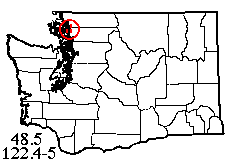 |
23 VI 1990: On June 23, I felt moderately rested from the California marathon, and Larry McTigue felt a sudden "beach craving," so we visited three beaches in the area south of Bellingham. These included Larrabee State Park and Clayton Bay on Chuckanut Drive, and a very little-known public access beach at the west end of Samish Island (which is connected to the mainland north of Padilla Bay). At the latter site I found my second specimen of the "seaside earwig" Anisolabis maritima. There were a few interesting spiders on the weirdly-sculptured sea cliffs north of Clayton Bay, and we also visited two sites especially for spider collecting: some roadside fields on Bay View Ridge and a salt marsh in the tidal section of the Samish River.
 |
8 VII 1990: Things have been quieter since May, but I have managed to get out a few times. Most recently, I accompanied the Native Plant Society to Quartz Mountain and vicinity, south of Cle Elum. This was actually supposed to be a joint trip with the Scarabs which yr editor quite forgot to announce (mea culpa, mea culpa...culpa culpa, mea mea). Even without notice, Scarabs Kirk, Lucian, Adams, and Albright (besides me) showed up. Even though the itinerary was the "hippity-hop" type of a typical butterfly trip, 6 sites in as many hours, some interesting spiders were still taken, including one new one from the 6290-foot summit of Quartz Mountain. By the way, does anyone know the significance of the fenced enclosure there, with some arcane metal structure in the middle and radioactive-warning signs around?
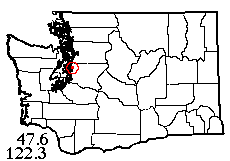 |
10 VIII 1990: Backyard entomology with a vengeance: yr editor recently was walking down the alley behind his home, when lo and behold, something very strange came crawling across. It proved to be a composite: a spider wasp (Pompilidae) dragging a paralyzed spider (Callobius sp.) much larger than it was. Both were collected (the wasp only with some trouble, since I had no net, but it kept returning to look for the spider I had stolen from it)! This is the first time I have succeeded in collecting both a spider wasp and its prey together. The spider was immature and couldn't be identified to species, so I decided to keep it and find out if it would ever recover from the paralysis of the wasp's sting. Within a month (by which time, in nature, the wasp's larva would have eaten it), the spider started to twitch, and gradually became semi-mobile, but never reached full normal mobility. It did manage to molt to maturity on Sept. 27, and turned out to be the common Callobius pictus.
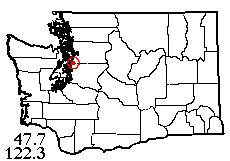 |
29 IX 1990: Scarab Moser's daughter Kerstin chose "bog spiders" as her high school science project, clearly with the idea in mind of getting help from "uncle Rod." However, I gained something from the project also: an interesting field day at a place I'd never visited before, Chase Lake in Edmonds. This has been a favorite spot with local entomologists since Trevor Kincaid in the early 1920s. It has suffered somewhat from being surrounded by houses, but the bog itself belongs to Edmonds Public Schools and is called a "natural laboratory." You can walk (with rubber boots) quite a way out on the Sphagnum mat, though the water underneath is up to 7 m deep. Among the 11 spider species I collected in an hour and a half were the first western Washington specimen of the tiny wolf spider Pardosa insularis and my second Washington sample of Theonoe stridula, which at 0.6 mm is our smallest spider. Another interesting feature of this bog, previously unknown to me, is the abundance of the very small black field crickets of the genus Nemobius. These neat little insects closely resemble the larger Gryllus, widely heard in eastern and southern Washington, but they are only about 1/4 the size. I don't known anywhere else around Seattle where Nemobius occur.
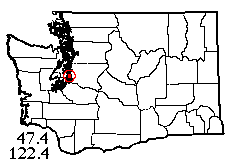 |
13 X 1990: Saturday, October 13, I did a spider lecture and walk for the Vashon Island Public Library and Vashon Audubon which was a roaring success. The room was packed and there was a waiting list for the walk, which I had limited to 15 because it takes so long for each person to look at each spider. (If only we could drum up such enthusiasm for Scarabs meetings!) We visited a site called "Whispering Firs Bog," the object of a current preservation effort. A sizable chunk already belongs to the Vashon Land Trust, a conservation group, and the far shore to a sympathetic landowner, but about 1/3 of the bog area awaits acquisition. The bog itself is a very neat place, with extensive springy moss mat and scattered miniature firs. The surrounding land is typical, extensively altered Puget Sound second growth, but with a nice diverse spider fauna. Counting all habitats, I got exactly 40 species.
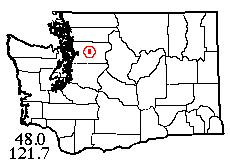 |
12 XI 1990: Yr editor was all set to do a lot of collecting this fall. But as we know, the weather was not exactly conducive. We seem to have had about two passably nice weekends since October. On one of these, November 12, I had planned to visit the Silverton area on the upper reaches of the south fork Stillaguamish River. But what do you know ... flood conditions had washed out the highway 11 miles above Granite Falls! There was a hundred feet of gravel and boulders on the road, then a stretch of missing pavement, then a very scenic waterfall flowing over the highway and plunging off the downhill edge. In view of this, we stopped there and I collected around the Lake 22 trailhead. The result was 24 spider species, none of them very spectacular. Better luck next time...
This page last updated 7 April, 2024